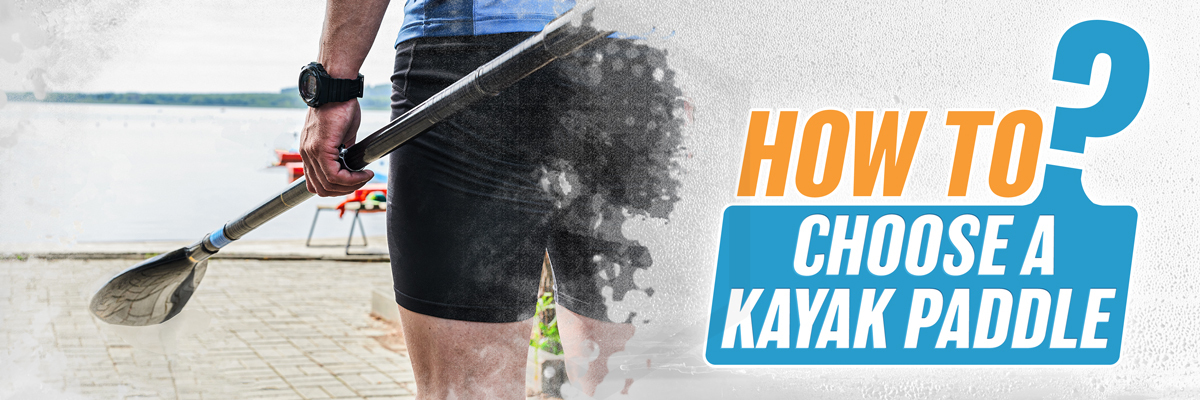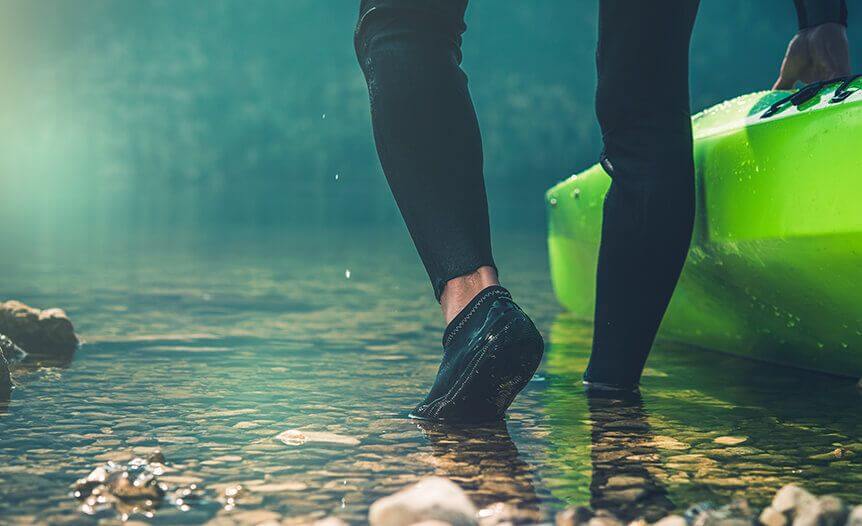How to Choose your Kayak Paddles

In most kayaks, a paddle is your primary form of propulsion, and you may be surprised there are many different styles and types available. When you're looking for new kayak paddles, you may be surprised at the sheer quantity available. You may well ask, don't they all do the same thing?
Well, the answer is yes and no. There are differences in blade design, shaft construction, materials, and length. The kayak paddles you choose can fit your particular kayaking style, which means you get the most benefit from them.
This article will explain the many differences between kayak paddles and what will work best with you. If you have a lot of experience or are a beginner at the sport, you can find a paddle that works with you and makes paddling more effortless and enjoyable.
The key features of a kayak paddle
A kayak paddle has three key features: blade design, overall length, and construction materials. These features will work together to form a perfect paddle for your kayaking style.
Blade Design
The specific design of your paddle blades will act differently when they enter the water. The way you paddle and the type of water you encounter will generally determine which blade shape is most suitable.
High Angle
A high-angle paddle is for a vertical stroke, and its primary purpose is for speed and power. These paddles are commonly used in white water conditions where fast and aggressive strokes are standard. The high-angle paddle is designed to move a lot of water during each stroke. These blades will capture and hold the water during each stroke. The result is a faster kayaking experience.
These blades are suited for use where:
- You're carrying a lot of gear, (e.g., when fishing);
- Enjoy white water kayaking or covering a lot of distance in a day;
- You're into kayak surfing and need additional speed and power.
Low Angle
A low-angle paddle is more horizontal in comparison to a high-angle paddle. These paddles are designed for relaxed or touring styles of kayaking. If you're interested in taking in the sights and enjoying your time on the water, then using a low-angle paddle is best. Low-angle paddles are perfect for anyone starting in the sport, as technique is less important. Paddling using these blades requires less effort, and they are suited to anyone with limited fitness capabilities.
Low-angle paddles are made to be easy and efficient. If you spend a long day on the water, these are ideal as they will not tire you out. When people start kayaking, they'll usually use a low-angle paddle as these are forgiving when your technique is less defined.
The low-angle paddle is best for kayakers who:
- Are interested in a relaxing time on the water;
- Enjoy paddling for long periods, or interested in multi-day sessions;
- Prefer kayaking that is not strenuous on their body.
Wing Shaped
The wing-shaped paddle is designed to improve the forward stroke. These paddles are best used in racing situations and may only improve your speed in conjunction with technique. There are no real benefits for a wing-shaped paddle other than going forwards, and they are best used with sea kayaks, surf skis, and racing-style kayaks.
The wing-style paddle is beneficial when you're only interested in moving forward and looking to get the best time possible. You may find some benefits if you're crossing large expanses of water where time is crucial (e.g., island hopping in the sea). Recreational kayakers may find a wing-shaped paddle uncomfortable to use, especially if you need to use other paddles strokes.
A wing-shaped paddle is ideal for kayakers who:
- Are into racing or time trials;
- Are looking to cover distances in the shortest amount of time;
- Are interested in improving their forward stroke technique.
Dihedral
The dihedral blade has two power faces. When you look at the paddle from the front, you'll see two faces move away from the centre line. The middle part of the paddle is similar to the shaft, and it may look like one complete unit. The idea for the dihedral blade is to help grab the water and reduce the amount of vibration and flutter.
Dihedral blades will help reduce fatigue in long paddling sessions due to the reduction in fluttering. Paddles with dihedral blades are suited to kayakers who:
- Are needing a high-quality paddle for lengthy kayaking sessions;
- Looking for additional support to reduce any fatigue from paddling.
Paddle Length
There are several methods used to determine the optimum paddle length you require. You can use any of these methods or a combination of a few of them.
The right paddle for your body and your kayak
The length of your torso is an excellent way to gauge which paddle length will suit you the best. As you're sitting when using a paddle, your total height is not a perfect measurement to determine a suitable paddle size.
You may need some assistance when measuring your torso. Start by sitting in a chair and measure the distance from the seat to the tip of your nose. The measurement is your torso length. Another method for getting your torso length is when you're on the water in your kayak. If you hold your paddle directly out in front, and your hands are evenly spaced and sitting at around two-thirds from the centre of the shaft until the blade, then the paddle is an ideal size.
Kayaking Style
Your kayaking style can also help you choose the correct paddle size. If you're a thrill-seeker and going down rapids, then a shorter length is ideal. For recreational paddle, you can choose a standard size paddle.
Kayak Design
The wider your kayak, then the longer paddle you'll require. If you have a wide sit on top style kayak and a short shaft paddle, you'll find you need to lean towards the water; this action can limit the power achievable and tire you out quickly. With thinner sea kayaks, you can use a shorter paddle as the angle from the paddler to the water is sharper.
Adaptable Paddles
Paddles that have adjustment levels are often the easiest to use, as they can be altered to suit your kayak and your height. Many paddles are adjustable, allowing other users to take out your kayak, or you can use that paddle with different kayaks (such as when you have a sea kayak and a sit on top kayak).
Paddle Materials
The materials that make up your paddle can affect how comfortable it is to use. Generally, the lighter your paddle, the easier it is to use, especially on longer trips. When choosing your paddle, you need to find a good balance between cost, durability, and weight.
Carbon Fibre Paddles
Carbon fibre paddles are the best materials from which a paddle can be made. Carbon fibre is strong and very light, but this can come at a cost. Carbon fibre paddles are excellent for going on touring or spending the entire day on the water. Experienced paddlers often use these paddles.
Plastic Paddles
Plastic paddles are cost-effective while being durable. They tend to be heavier than other paddles, but they can be suitable for anyone new to kayaking or a backup paddle.
Aluminium Paddles
An aluminium paddle is slightly lighter than the plastic paddle, and these are excellent when you first start kayaking. These paddles tend to be cold on your hands, so you may need to add paddle grips to keep your hands warm.
Fibreglass Paddles
Fibreglass paddles are a great choice as these are reasonably priced, durable and lightweight. These paddles are considered mid-range and can handle a fair amount of abuse. Fibreglass paddles are excellent for recreational paddling if you're not quite ready for a full carbon fibre paddle.
Tips for strapping a kayak paddle to your roof racks
When you're lifting your kayak onto roof racks, you need to keep your paddle strapped in tightly. Wrap the paddle to your kayak with a couple of ratchet straps and make sure it is completely secure before you leave. Many paddles can separate into smaller parts (e.g., Elite Kayak Paddle), and it may be better to place your paddles in your vehicle.
FAQ about buying the best kayak paddles
Choosing paddles
Are carbon fibre paddles strong?
Carbon fibre paddles are considered the strongest paddles available. As carbon fibre can be brittle, these paddles are often made with a combination of fibreglass and plastics.
Can you use a canoe paddle in a kayak?
It is possible to use canoe paddles in a kayak, but you may find they are difficult and tiring to use. When you're in a canoe, you tend to sit in the water, and the paddles do not need to be very long. In a kayak, you sit on the water, which means your paddles are longer to reach the water.
What are the lightest kayak paddles?
The lightest paddles available are carbon fibre panels. The weight of your paddle is essential as you'll be holding and swinging it for several hours, and a heavy paddle can tire you out faster.
Kayak accessories
How do I choose a paddle leash?
A paddle leash should be a reasonable length and long enough to not hinder the paddler. For example, you may need a shorter leash with a junior paddle than you would with a standard paddle.
How does a kayak paddle leash work?
A paddle leash is attached to your kayak and the paddle. Most modern paddles are designed to float, but you can stop them from floating away if it falls overboard with a leash.
Where do you put a kayak paddle holder?
A paddle holder should be placed in a location that provides easy access. Ideally, a paddle holder is installed so the paddle will sit directly in from the kayak seat within easy reach of the operator. Paddle holders clips are screwed into the deck, and other styles may need to be installed into pre-existing rails.
Paddling techniques
Is fibreglass or aluminium kayak paddle better?
A fibreglass paddle is lighter and more durable than an aluminium paddle. Fibreglass paddles are more expensive than others, and most kayakers will start with an aluminium paddle and then upgrade as they become more experienced paddlers.
What happens when you use too long of a paddle for kayaking?
Having a longer than necessary paddle will not have a great deal of difference with performance. However, you'll need to work harder to get the same amount of speed and manoeuvrability.
What is the notch in a kayak paddle for?
The notch in your paddle is there to limit the amount of water running off your blades and into your kayak. Some paddles will also have a rubber ring on the shaft for the same purpose.
What makes a good fishing kayak paddle?
A good fishing paddle allows you to spend a lot of time on the water. Look for a paddle that's lightweight with low-angle blades. A paddle leash is vital when you're fishing as it'll help keep your hands free.
What type of paddle is best for kayaking?
A kayak paddle is best chosen for the style of kayaking you're doing. Many experienced paddlers will have a few different paddles suited to where they're going that day. For rivers and fishing, you need a paddle for manoeuvrability, and in lakes and saltwater, a paddle designed for speed is ideal.
Where to buy kayak paddles
At Kayaks2Fish, you can find an excellent assortment of paddles and other kayaking accessories (e.g., dry bags). Your paddle is an essential part of your kayak. As you'll be holding the paddles for the entire time your kayaking, you must get one that feels comfortable. Many kayakers start out using an aluminium paddle and then upgrade later when they have more experience. Having two paddles is always a good idea, as it is possible to damage or lose a paddle on long trips.
We stock a selection of the best paddles in Australia, and these are available for delivery or collection from our warehouse locations. We'll always provide the best service possible when you purchase from our store. If you need assistance in choosing the right paddles to suit you and your kayak, please call our local team. We'll ask the right questions and offer our expert advice on the best paddles for your situation.










